|
Hauling Out: 2008
September 30, 2008
|
After a couple unfavorable experiences with boatyards in
Rockland, I decided to look elsewhere for a new boatyard to
handle the mast stepping/unstepping. This, along with
the logistical challenges of having the boat in Buck's
Harbor (a significant distance from Rockland by road--about
2 hours), made Rockland an unlikely choice for future
launching, hauling, and mast work, despite its convenient
and close location to home in Whitefield.
Buck's Harbor is great, but
there is a lack of facilities nearby. During the
summer, I contemplated how to proceed, and thought long and
hard about various ways to deal with the mast--my least
favorite part of boat ownership, frankly, and now the one
portion that I was unable to do myself, at least without
engineering a suitable mast raising/lowering system that I
felt was safe and foolproof. This is still on my mind
and in the mental works, though I've not yet come up with
the solution that works for me.
I decided that I preferred
to drive my truck and trailer farther over the road in order
to make the various logistics of moving the boat from
mooring to boatyard, and dealing with multiple vehicles,
easier, and eventually I decided to try a nearby boatyard
that I'd seen before, Morse Cove Marine (formerly Devereaux
Marine), in Castine. This small yard was only about 14
miles by water from Buck's Harbor, and its land location was
on the way and convenient for vehicle drop-off and so forth.
However, this yard did not
have a ramp, meaning I could not use my trailer to
haul/launch the boat myself at this location.
Additionally, they performed all mast work on the hard only.
I decided that this all suited me well enough--the yard
could haul the boat in their Travelift and unstep the mast,
and I'd simply pick her up with the trailer later. I
made arrangements with Ethan Coit to haul the boat on Tuesday, September 30.
I'd hoped to bring the boat
around over the weekend before, but the weather was foul the
entire time, so I was unable to do so. So, at 0500
Tuesday morning, along with a friend in a second vehicle, we
departed Whitefield and drove to Buck's Harbor, depositing
one vehicle at Morse Cove Marine along the way.
Once on the boat, we got
underway immediately, once I'd thrown together a quick
course for the GPS (always, just in case), and dropped the
mooring at 0730. We motored the 14.3 miles
around Cape Rosier and up the beginnings of the Penobscot
River to Morse Cove, just east of Cape Jellison. The
sun highlighted some nice fall foliage on Cape Rosier as we
went by. |
|
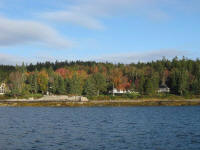
|
The trip was uneventful; what wind there was was directly
from the north, as much on the nose as it could be, and not
particularly strong, though it would have been nice if it'd
been from the quarter instead. It was fairly chilly
with the sun beneath the clouds, but pleasant when the sun
would pop out from time to time.
We arrived at 1030 and
picked up a mooring, and then proceeded to strip the boat of
sails, boom, and dodger. Shortly after 1200, they were
ready for us, so I motored the boat into the Travelift slip.
Morse Cove has an old Travelift that lacks many of the
adjustments found on newer versions, so they haul boats
stern first; I had to release the backstay and install the
main halyard off one of the genoa tracks to support the
mast, so that the aft crossbar on the Travelift would clear.
(Ethan had informed me of this on the mooring, and we were
ready when we came in.)
Haulout was uneventful,
just the way it ought to be. |
|
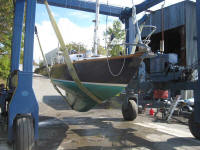
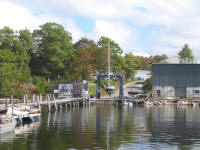
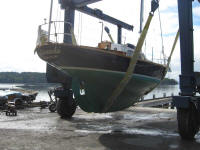
|
I had thought they might bring the boat up the short hill to
the boatyard and block her right away, but clearly they
planned to wait on that, perhaps till after we left.
Ethan told me that they would probably unstep the mast later
that day, and, after we discussed a few of my preferences
for the mast storage and boat blocking for transport, So,
with no further reason to hang around, we retrieved the
dinghy and headed home, leaving the boat in the lift.
The next morning, Ethan
called me to let me know that the mast was done; I planned
to head up with the truck on Thursday morning.
Unfortunately, come the day it was raining hard, and looked
to continue--particularly downeast--for much of the day.
So I changed my plans to head up on Friday morning instead.
I departed early on Friday,
and arrived at the boatyard just after 0800. My first
step was to secure the mast to the deck, which I
accomplished with several lines and some padding as needed.
Then, I positioned the trailer and got it under the boat.
I found that the blocking beneath the boat was just a little
too high; at the full lift of the airbags, the trailer
wouldn't quite lift the boat off the blocking.
To get around this, I
lowered the trailer and added some 2X blocking to the tops
of the beams, then raised it again. The tiny air
compressor in my truck can't keep up with the air needs, and
since I'd exhausted the air tank supply during my earlier
attempts to lift the boat, I had to wait for a while for the
compressor to refill the tanks enough to continue; while I
waited, I prepared straps over the boat for the transport.
Eventually, I had enough
air to proceed, and got the boat off the keel blocks--not
without some minor persuasion on the forward blocks, though.
I had asked for the keel to be 16" or so above the ground,
but it had been blocked significantly higher. No big
deal--just more work for me.
With the boat securely
loaded and strapped down, I departed the boatyard at about
1000 and drove to the shop, arriving just after 1130.
It was smooth sailing, though the Castine Road (Rt 175) was
bumpy and uneven and slow going.
At the shop, I backed the
trailer beneath my gantry crane so that I could remove the
mast. |
|
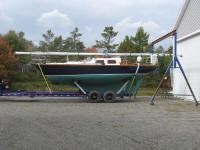
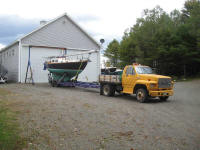
|
After lunch, I removed all the standing and running rigging
from the mast. This was my first opportunity to
inspect the new jumper strut that Journey's End had made up
back in May, after they
trashed the jumpers while stepping the mast. I'd
known from the beginning (not quite soon enough to have them
change it) that they'd installed the new jumper with the
little adjusting nut on the wrong side--inside (beneath) the
crossmember rather than outside (on top of) it. This
wasn't a big enough problem to worry about during the
season, so I left it.
The new strut was made from a
solid piece of aluminum, half the length of which they'd
turned down on a lathe to fit into the socket. At the
outer end, they'd milled a recess into the tube to accept
the threaded stud. All in all, it was an
effective and ingenious repair, done with materials on hand
and relatively quickly. I will get some pictures
later.
With the mast stripped of
everything except the roller furling headstay, I tied a line
around the spreader bases, which I figured were about the
balance point (what with the extra weight at the base of the
mast from winches, cleats, and the roller furling drum) and
lifted it off the boat with a block and tackle on my crane.
It was easy, though the balance point wasn't quite right,
and the mast was still butt-heavy. Still, I had no
trouble lowering it to the ground and some waiting
sawhorses. |
|
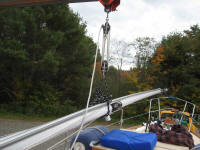
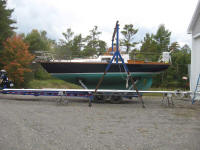
|
Afterwards, I moved the boat around to the other side of the
building, closer to the hose, so that I could powerwash the
bottom and be closer when it was time to winterize the
engine, which I planned to do over the weekend. My
plan was to get all the winterizing and water-related chores
out of the way before I put the boat inside the shop for at
least part of a winter's work and upgrades.
Click
here to begin the day-by-day log of the 2008 winter refit. |
|
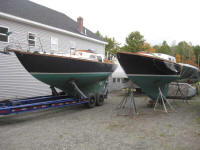
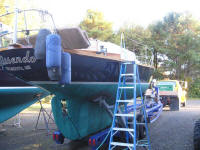
|
|